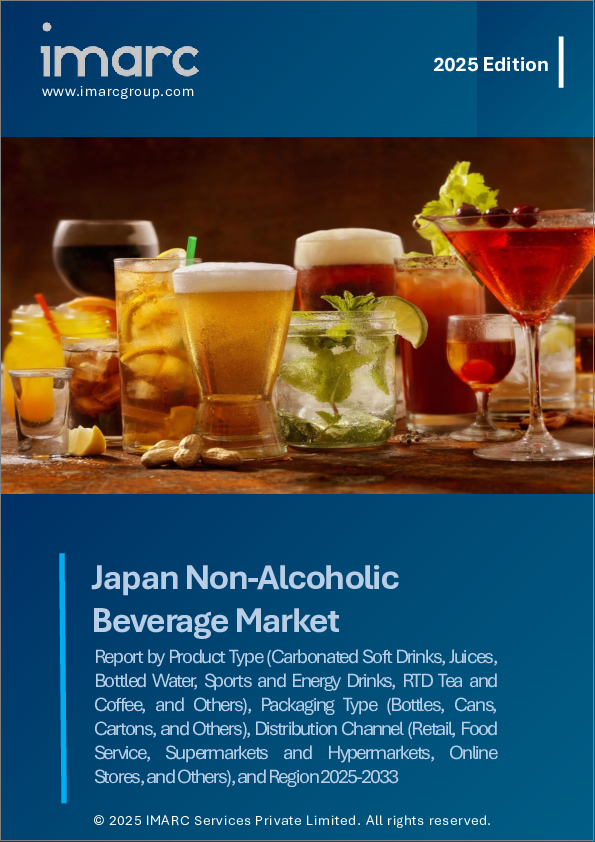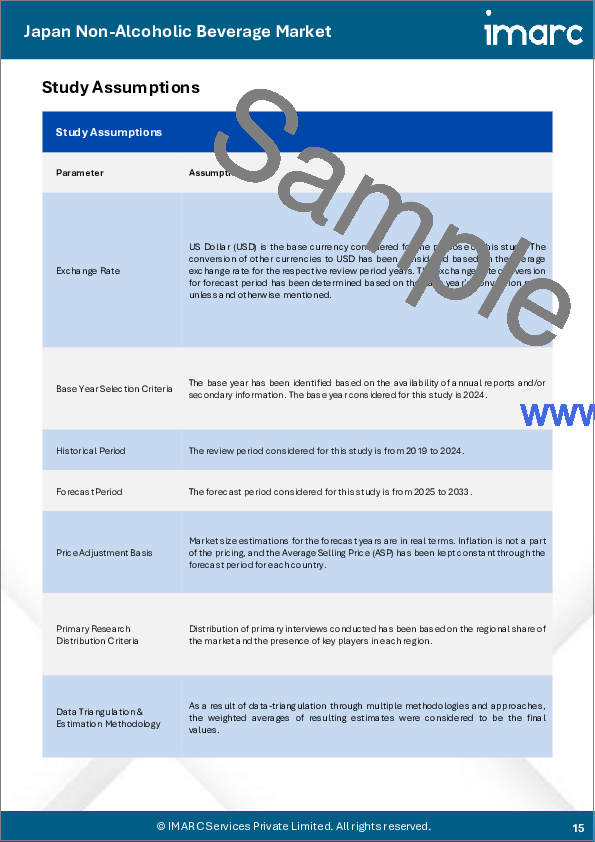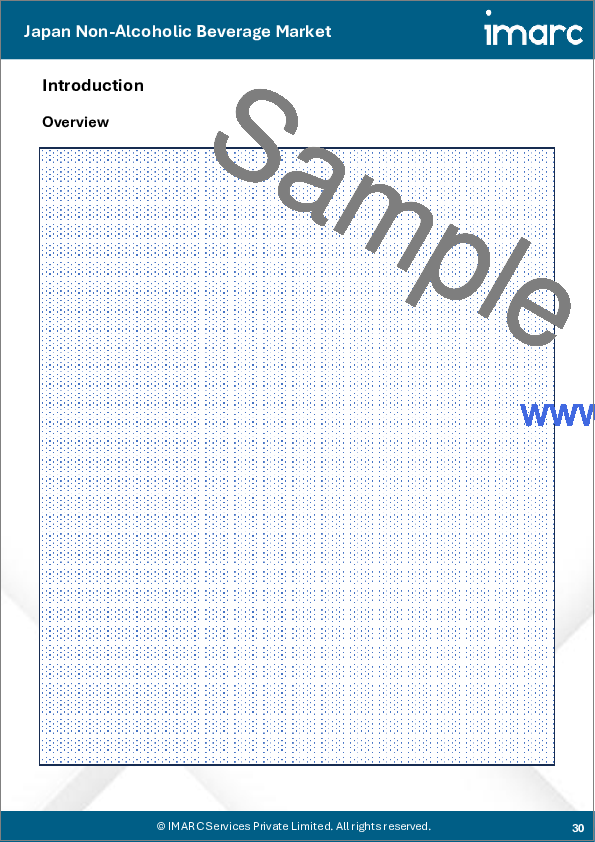|
|
市場調査レポート
商品コード
1729352
日本のノンアルコール飲料市場レポート:製品タイプ、包装タイプ、流通チャネル、地域別、2025年~2033年Japan Non-Alcoholic Beverage Market Report by Product Type, Packaging Type, Distribution Channel, and Region 2025-2033 |
||||||
カスタマイズ可能
|
|||||||
| 日本のノンアルコール飲料市場レポート:製品タイプ、包装タイプ、流通チャネル、地域別、2025年~2033年 |
|
出版日: 2025年05月01日
発行: IMARC
ページ情報: 英文 121 Pages
納期: 5~7営業日
|
全表示
- 概要
- 目次
日本のノンアルコール飲料市場規模は2024年に376億米ドルに達しました。今後、IMARC Groupは、2033年には758億米ドルに達し、2025~2033年の成長率(CAGR)は7.70%になると予測しています。低糖質で人工添加物を含まず、水分補給、ビタミン、抗酸化物質などの機能的特典を提供する、より健康的な飲料オプションに対する需要の増加が、主に市場を牽引しています。
本レポートで扱う主な質問
- 日本のノンアルコール飲料市場はこれまでどのように推移し、今後どのように推移するのか?
- COVID-19が日本のノンアルコール飲料市場に与えた影響は?
- 日本のノンアルコール飲料市場の製品タイプ別区分は?
- 日本のノンアルコール飲料市場の包装タイプ別区分は?
- 日本のノンアルコール飲料市場の流通チャネル別区分は?
- 日本のノンアルコール飲料市場のバリューチェーンにおける様々なステージとは?
- 日本のノンアルコール飲料の主な促進要因と課題は?
- 日本のノンアルコール飲料市場の構造と主要プレーヤーは?
- 日本のノンアルコール飲料市場における競合の程度は?
目次
第1章 序文
第2章 調査範囲と調査手法
- 調査の目的
- ステークホルダー
- データソース
- 市場推定
- 調査手法
第3章 エグゼクティブサマリー
第4章 日本のノンアルコール飲料市場:イントロダクション
- 概要
- 市場力学
- 業界動向
- 競合情報
第5章 日本のノンアルコール飲料市場情勢
- 過去および現在の市場動向(2019~2024年)
- 市場予測(2025~2033年)
第6章 日本のノンアルコール飲料市場:製品タイプ別の内訳
- 炭酸飲料
- ジュース
- ボトルウォーター
- スポーツドリンクとエナジードリンク
- RTD紅茶とコーヒー
- その他
第7章 日本のノンアルコール飲料市場:包装タイプ別の内訳
- ボトル
- 缶
- カートン
- その他
第8章 日本のノンアルコール飲料市場:流通チャネル別の内訳
- 小売り
- フードサービス
- スーパーマーケットとハイパーマーケット
- オンラインストア
- その他
第9章 日本のノンアルコール飲料市場:競合情勢
- 概要
- 市場構造
- 市場企業のポジショニング
- 主要成功戦略
- 競合ダッシュボード
- 企業評価象限
第10章 主要企業のプロファイル
第11章 日本のノンアルコール飲料市場:業界分析
- 促進要因、抑制要因、機会
- ポーターのファイブフォース分析
- バリューチェーン分析
第12章 付録
Japan non-alcoholic beverage market size reached USD 37.6 Billion in 2024. Looking forward, IMARC Group expects the market to reach USD 75.8 Billion by 2033, exhibiting a growth rate (CAGR) of 7.70% during 2025-2033. The increasing demand for healthier beverage options that are low in sugar, free from artificial additives, and offer functional benefits like hydration, vitamins, or antioxidants, is primarily driving the market.
Non-alcoholic beverages, also known as soft drinks, encompass a wide variety of drinkable refreshments that do not contain alcohol. These beverages serve not only as thirst quenchers but also as integral components of many cultures, rituals, and daily routines. Ranging from traditional drinks like tea, coffee, and cocoa to the effervescent world of sodas and from refreshing fruit juices to health-centric options like kombucha and herbal infusions, these drinks cater to a diverse array of tastes and preferences. Often, the consumption of such beverages is influenced by factors like climate, regional ingredients, and cultural practices. Innovations in the beverage industry have also led to the introduction of new flavors and combinations, further expanding the spectrum of choices. As more individuals gravitate towards health-conscious choices, the demand for organic, low-calorie, and nutrient-rich non-alcoholic beverages has risen, indicating a dynamic shift in consumption patterns.
Japan Non-Alcoholic Beverage Market Trends:
The non-alcoholic beverage market in Japan is experiencing robust growth, driven by several key factors. Firstly, changing consumer preferences has played a pivotal role in the market's expansion. Health-conscious consumers are increasingly opting for non-alcoholic alternatives over sugary, high-calorie drinks. Furthermore, the rising awareness of the harmful effects of excessive alcohol consumption has prompted many individuals to seek healthier beverage options. Additionally, the growing trend of mindful drinking has propelled the demand for non-alcoholic beverages. Consumers are seeking flavorful, sophisticated alternatives that allow them to enjoy social occasions without the intoxicating effects of alcohol. Consequently, innovative beverage companies have responded with a plethora of non-alcoholic options that cater to various tastes and preferences. Apart from this, the influence of marketing and branding, which has successfully created aspirational and trendy images of non-alcoholic beverage brands, appealing to younger demographics who are more health-conscious and socially aware, is expected to drive the non-alcoholic beverage market in Japan during the forecast period.
Japan Non-Alcoholic Beverage Market Segmentation:
Product Type Insights:
- Carbonated Soft Drinks
- Juices
- Bottled Water
- Sports and Energy Drinks
- RTD Tea and Coffee
- Others
Packaging Type Insights:
- Bottles
- Cans
- Cartons
- Others
Distribution Channel Insights:
- Retail
- Food Service
- Supermarkets and Hypermarkets
- Online Stores
- Others
Competitive Landscape:
The market research report has also provided a comprehensive analysis of the competitive landscape. Competitive analysis such as market structure, key player positioning, top winning strategies, competitive dashboard, and company evaluation quadrant has been covered in the report. Also, detailed profiles of all major companies have been provided.
Key Questions Answered in This Report:
- How has the Japan non-alcoholic beverage market performed so far and how will it perform in the coming years?
- What has been the impact of COVID-19 on the Japan non-alcoholic beverage market?
- What is the breakup of the Japan non-alcoholic beverage market on the basis of product type?
- What is the breakup of the Japan non-alcoholic beverage market on the basis of packaging type?
- What is the breakup of the Japan non-alcoholic beverage market on the basis of distribution channel?
- What are the various stages in the value chain of the Japan non-alcoholic beverage market?
- What are the key driving factors and challenges in the Japan non-alcoholic beverage?
- What is the structure of the Japan non-alcoholic beverage market and who are the key players?
- What is the degree of competition in the Japan non-alcoholic beverage market?
Table of Contents
1 Preface
2 Scope and Methodology
- 2.1 Objectives of the Study
- 2.2 Stakeholders
- 2.3 Data Sources
- 2.3.1 Primary Sources
- 2.3.2 Secondary Sources
- 2.4 Market Estimation
- 2.4.1 Bottom-Up Approach
- 2.4.2 Top-Down Approach
- 2.5 Forecasting Methodology
3 Executive Summary
4 Japan Non-Alcoholic Beverage Market - Introduction
- 4.1 Overview
- 4.2 Market Dynamics
- 4.3 Industry Trends
- 4.4 Competitive Intelligence
5 Japan Non-Alcoholic Beverage Market Landscape
- 5.1 Historical and Current Market Trends (2019-2024)
- 5.2 Market Forecast (2025-2033)
6 Japan Non-Alcoholic Beverage Market - Breakup by Product Type
- 6.1 Carbonated Soft Drinks
- 6.1.1 Overview
- 6.1.2 Historical and Current Market Trends (2019-2024)
- 6.1.3 Market Forecast (2025-2033)
- 6.2 Juices
- 6.2.1 Overview
- 6.2.2 Historical and Current Market Trends (2019-2024)
- 6.2.3 Market Forecast (2025-2033)
- 6.3 Bottled Water
- 6.3.1 Overview
- 6.3.2 Historical and Current Market Trends (2019-2024)
- 6.3.3 Market Forecast (2025-2033)
- 6.4 Sports and Energy Drinks
- 6.4.1 Overview
- 6.4.2 Historical and Current Market Trends (2019-2024)
- 6.4.3 Market Forecast (2025-2033)
- 6.5 RTD Tea and Coffee
- 6.5.1 Overview
- 6.5.2 Historical and Current Market Trends (2019-2024)
- 6.5.3 Market Forecast (2025-2033)
- 6.6 Others
- 6.6.1 Historical and Current Market Trends (2019-2024)
- 6.6.2 Market Forecast (2025-2033)
7 Japan Non-Alcoholic Beverage Market - Breakup by Packaging Type
- 7.1 Bottles
- 7.1.1 Overview
- 7.1.2 Historical and Current Market Trends (2019-2024)
- 7.1.3 Market Forecast (2025-2033)
- 7.2 Cans
- 7.2.1 Overview
- 7.2.2 Historical and Current Market Trends (2019-2024)
- 7.2.3 Market Forecast (2025-2033)
- 7.3 Cartons
- 7.3.1 Overview
- 7.3.2 Historical and Current Market Trends (2019-2024)
- 7.3.3 Market Forecast (2025-2033)
- 7.4 Others
- 7.4.1 Historical and Current Market Trends (2019-2024)
- 7.4.2 Market Forecast (2025-2033)
8 Japan Non-Alcoholic Beverage Market - Breakup by Distribution Channel
- 8.1 Retail
- 8.1.1 Overview
- 8.1.2 Historical and Current Market Trends (2019-2024)
- 8.1.3 Market Forecast (2025-2033)
- 8.2 Food Service
- 8.2.1 Overview
- 8.2.2 Historical and Current Market Trends (2019-2024)
- 8.2.3 Market Forecast (2025-2033)
- 8.3 Supermarkets and Hypermarkets
- 8.3.1 Overview
- 8.3.2 Historical and Current Market Trends (2019-2024)
- 8.3.3 Market Forecast (2025-2033)
- 8.4 Online Stores
- 8.4.1 Overview
- 8.4.2 Historical and Current Market Trends (2019-2024)
- 8.4.3 Market Forecast (2025-2033)
- 8.5 Others
- 8.5.1 Historical and Current Market Trends (2019-2024)
- 8.5.2 Market Forecast (2025-2033)
9 Japan Non-Alcoholic Beverage Market - Competitive Landscape
- 9.1 Overview
- 9.2 Market Structure
- 9.3 Market Player Positioning
- 9.4 Top Winning Strategies
- 9.5 Competitive Dashboard
- 9.6 Company Evaluation Quadrant
10 Profiles of Key Players
- 10.1 Company A
- 10.1.1 Business Overview
- 10.1.2 Product Portfolio
- 10.1.3 Business Strategies
- 10.1.4 SWOT Analysis
- 10.1.5 Major News and Events
- 10.2 Company B
- 10.2.1 Business Overview
- 10.2.2 Product Portfolio
- 10.2.3 Business Strategies
- 10.2.4 SWOT Analysis
- 10.2.5 Major News and Events
- 10.3 Company C
- 10.3.1 Business Overview
- 10.3.2 Product Portfolio
- 10.3.3 Business Strategies
- 10.3.4 SWOT Analysis
- 10.3.5 Major News and Events
- 10.4 Company D
- 10.4.1 Business Overview
- 10.4.2 Product Portfolio
- 10.4.3 Business Strategies
- 10.4.4 SWOT Analysis
- 10.4.5 Major News and Events
- 10.5 Company E
- 10.5.1 Business Overview
- 10.5.2 Product Portfolio
- 10.5.3 Business Strategies
- 10.5.4 SWOT Analysis
- 10.5.5 Major News and Events
11 Japan Non-Alcoholic Beverage Market - Industry Analysis
- 11.1 Drivers, Restraints and Opportunities
- 11.1.1 Overview
- 11.1.2 Drivers
- 11.1.3 Restraints
- 11.1.4 Opportunities
- 11.2 Porters Five Forces Analysis
- 11.2.1 Overview
- 11.2.2 Bargaining Power of Buyers
- 11.2.3 Bargaining Power of Suppliers
- 11.2.4 Degree of Competition
- 11.2.5 Threat of New Entrants
- 11.2.6 Threat of Substitutes
- 11.3 Value Chain Analysis






